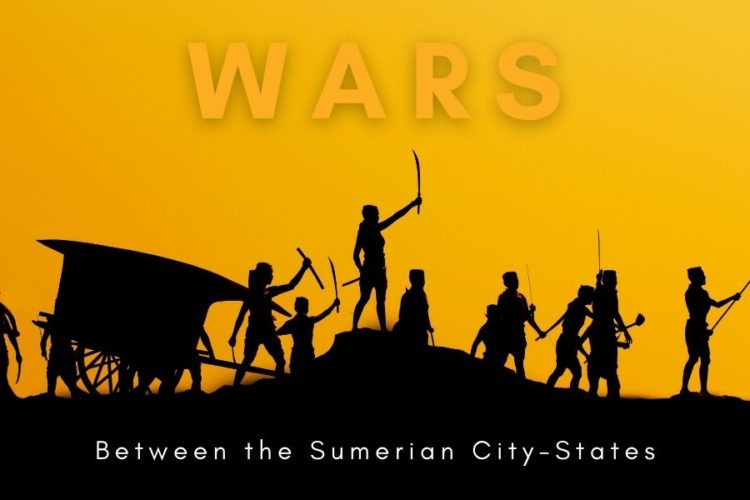In Sumer, just like in other countries, there were regional conflicts with nearby city-states. Most of the time, these city-states would go to war to acquire more territory and to gain glory. An army would surround a rival city and employ sappers and battering rams. The ancient armies also made use of light infantry and chariots. The soldiers carried axes, shields, swords, knives, clubs, spears, slingshots, sickles, and maces. Most used daggers, spears and axes. In addition to rivalries, other causes of conflict included wealth, resources, and prestige. In Mesopotamian art, artists would glorify military victories.

Tactics
The number of wars between these rival Sumerian city-states was on the rise during the Early Dynastic period. Often the cities at war were very close to each other. The cities of Lagash and Umma, for example, fought each other many times. Notably, they were just 25 miles away from each other. The longest distance between two fighting cities was between Elam and Kish. The distance between the cities was 160 miles. Each army would only have to march for a few days at most.
Historians do not know much about the fighting tactics. In Sumerian writings, victories are glorified and details on how the war was fought are scarce. It was known that soldiers used sappers and battering rams after arriving at and surrounding a city.
The defense would fight back from their towers. Even though some cities did not fortify their walls for defensive purposes, walls were ultimately meant to protective in nature – against floods and wild animals.
Walls were also used to communicate the level of a city’s wealth and power. With time, however, cities began using walls for defense. Towards the 13th century, cities started using moats as defense measures as well. Once an enemy captured a city, they would destroy its walls to humiliate its people.
Enemies would also loot the captured city, and they would capture all or some of the city dwellers to use as slaves. The victor would dedicate some of the spoils to the city’s patron deity.
Causes of War
Many city-states went into war with enemy city-states. Some of the cities that battled against each other include Umma and Lagash, and the cities of Kish, Uruk, and Ur. According to records, the wars were fought over resources.
Trade routes also caused conflict. Resources such as wood and stone – materials used to construct cities – were transported through these routes. Sumers controlled these routes, and the Gutians and Elamites would raid these essential supplies. One king, King Meskiaggasher, went to war in the Zagros Mountains to get metal, timber, and stone. The Sumerian myths of kings going into battle against each other in opposition to the Kingdom of Aratta is believed to be a representation of the campaigns in Persia for lapis lazuli and tin.
Some wars of course began when one city tried to show dominance over another. This occurred when King Agga of Kish tried to make Gilgamesh, who was then the King of Uruk, submit to Kish. Gilgamesh was displeased, and he responded by going to war with Kish. Many cities formed military alliances to protect themselves against invasion and raiding. The king with the winning battalion would enjoy wealth and prestige.
With time, the number of people living in villages became fewer than those living in the cities. Most likely, villagers felt the cities were more protected. This indicates that there was a lot of warfare in Sumer.
The Armies
During the Uruk period, the kings of the Sumer city-states began forming armies and so emerged the creation of new military professions. Eventually, there were thousands of soldiers. Some armies contained around 5,000 soldiers, while others could boast of even more. The bigger armies had numerous units. A single military unit consisted of between 60 and 100 men. Combining these smaller units would also then create a larger unit.
The Shub-Lugal were household troops, and Sargon’s army mostly relied on these troops. Soldiers that were given plots of land were referred to as “Niksum.” Other types of soldiers include: skirmishers or Nim (tr. “flies”) and the Sagi-mah (tr. “Chief Cup Bearer”) who fought for the King of Akkad, Sargon.
Weapons
Soldiers with spears would form organized units. Light infantry would be equipped with bows and spears to offer support to the main army. The chariots they used had four small wheels, and the sides were chest-height. Every chariot contained two soldiers with one serving as a driver while the other performed the duties of a soldier. Mules, donkeys, or crossbreeds would be used to pull the chariots. Horses were considered very expensive and were therefore not used.
Sumerian soldiers underwent training, and they were well equipped to fight. According to archaeological studies, they used war carts, bronze, and iron weapons, as well as spears, sickle swords, maces, slings, knives, clubs, spears, axes, and shields. The most common weapons of choice, however, were spears, daggers, and axes. Armor consisted of copper helmets and bronze cloaks decorated with metal discs.
By 2100 BCE, the Sumerians had developed bronze scale armor. Light infantrymen are depicted wearing no armor, but rather skirts made of feathers. Prior to the Akkadian Empire, soldiers fought using basic bows. During Sargon’s reign, composite bows were used. It is possible that the Akkadians learned about the bow from nomadic peoples. It was commonly used on Mesopotamian battlefields, and many soldiers felt that the weapon was indispensable.
Conclusion
In most parts of the world, neighboring communities undergo conflict from time to time. These conflicts could be because of territory or wealth. Things were no different in Sumer; neighboring cities would often go to war with their neighbors, each employing well-organized soldiers with sophisticated weapons. Winning, of course, meant more prestige and even more importantly – more wealth.

